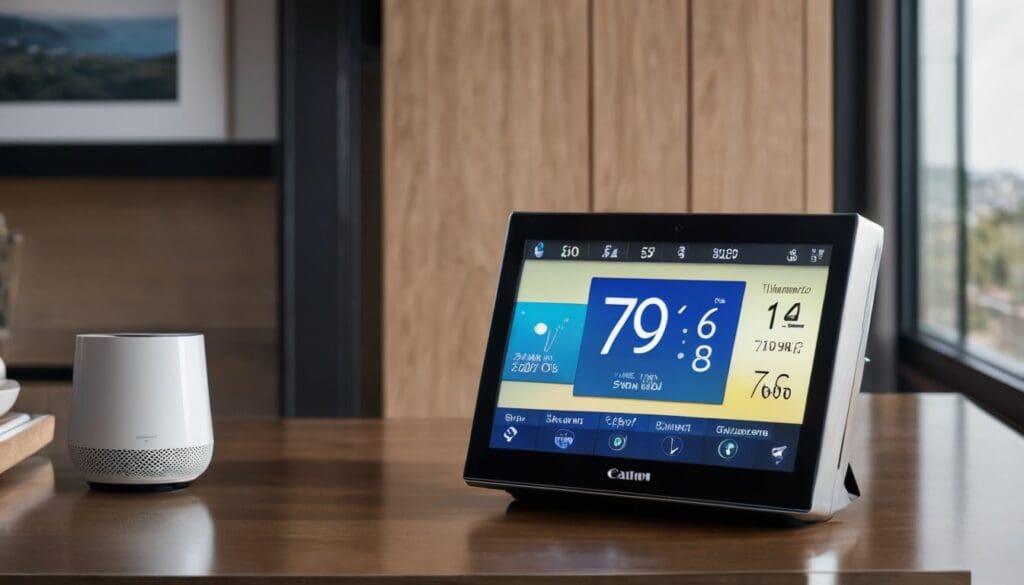As we strive for a greener Earth, our homes have a big role to play. In the UK alone, households account for 25% of carbon emissions. Our guide explores how smart home technologies can drive sustainable living and cut down energy usage.
Discover eco-friendly living with a tech twist!
Key Takeaways
- Smart homes in the UK can help reduce carbon emissions, which currently account for 25% of the country’s total emissions from households. By using internet-connected devices like Amazon Echo and Nest thermostat, homeowners can manage their energy use more efficiently.
- Sustainable smart home systems include energy-efficient appliances, climate-friendly technology allowing adjustment to weather conditions, and eco-friendly automation that integrates with renewable sources like solar panels.
- Consumer demand for sustainable smart homes is growing; people are willing to pay more for features such as energy efficiency (92% importance), durable materials (89%), and smart resource management (91%).
- Environmental concerns include electronic waste from outdated devices polluting ecosystems. To combat this, proper disposal, recycling programmes, and governmental regulations on production practices are essential.
- For a sustainable smart home industry future, collaboration among manufacturers to implement sustainability in design is key—highlighting the need for durable products made from sustainable materials that support conservation efforts.
What is a Smart Home?
A smart home refers to a residence that utilises internet-connected devices to enable remote monitoring and management of appliances and systems, such as lighting, heating, and security.
These connected devices can be controlled through a central hub or smartphone app. Examples of smart home systems include Amazon Echo, Google Home, Philips Hue lighting system, and Nest thermostat.
Overview
At the heart of smart home technologies lies the concept of interconnectivity. Devices communicate with each other to optimise your home’s energy use and provide convenience at your fingertips.
Imagine adjusting temperature, lighting, and even watering plants with a simple voice command or through a smartphone app. This isn’t just about luxury; it’s about crafting an eco-smart living space that conserves resources.
Smart homes integrate systems like energy monitoring and renewable energy management to reduce electricity consumption. They employ climate-friendly technology to lessen the carbon footprint of households.
By adopting green home technology, you are not only streamlining daily tasks but also investing in environmentally conscious automation that supports sustainable lifestyle practices.
Examples of Smart Home Systems
- Energy-efficient appliances: Smart home systems encompass a range of appliances designed to minimise energy consumption, such as smart thermostats, LED lighting, and energy-efficient refrigerators.
- Climate-friendly technology: These systems use sensors and data analytics to optimise energy usage based on weather conditions, reducing environmental impact while maintaining comfort.
- Eco-friendly home automation: Smart home systems enable the integration of renewable energy sources like solar panels and wind turbines, contributing to sustainable energy management.
- Internet of Things (IoT) devices: IoT devices allow for seamless connectivity and communication among various smart home components, optimising energy usage while enhancing convenience.
- Energy-saving smart home devices: These devices are programmed to automatically adjust settings according to occupancy or user preferences, further reducing energy consumption.
- Environmental responsibility in design: Some smart home manufacturers prioritise sustainable materials and production processes, ensuring that their products have a minimal environmental footprint.
The Importance of Smart Home Sustainability
Smart home sustainability is crucial for reducing energy consumption and minimising environmental impact. While smart home technology offers numerous benefits, it also poses potential drawbacks to the environment, particularly in terms of electronic waste.
Benefits of Smart Home Technology
Smart home technology offers energy-efficient solutions for environmentally conscious individuals. With remote control home appliances and energy-saving smart devices, homeowners can optimise energy usage, leading to reduced utility bills and a smaller carbon footprint.
Additionally, eco-friendly home automation systems provide convenient climate-friendly technology for sustainable living. These smart appliances not only enhance convenience but also contribute to a greener lifestyle by supporting conservation and environmental efforts.
The use of ecosmart home devices further promotes sustainable living solutions. By integrating green technology such as energy-efficient appliances and internet of things (IoT) connectivity, households can actively participate in environmental conservation while enjoying the benefits of modern home automation.
Environmental Drawbacks of Smart Homes
While smart homes offer numerous benefits, there are also environmental drawbacks to consider. The increased energy consumption and electronic waste generated by smart home devices can have a negative impact on the environment.
Smart homes often rely on energy-intensive technologies, leading to higher electricity usage, which contributes to carbon emissions and exacerbates climate change. Additionally, the rapid turnover of smart devices leads to significant electronic waste that ends up in landfills, posing risks of pollution and resource depletion.
It is essential for environmentally conscious individuals to be aware of these drawbacks and seek sustainable solutions when implementing smart home technologies.
To address the environmental impact of smart homes, it’s crucial to prioritise energy-efficient and durable products while minimising electronic waste. By choosing eco-friendly devices and properly disposing of old electronics through recycling programmes, individuals can mitigate the negative effects associated with smart home technology.
Environmental Impact of Electronic Waste
Let’s explore the environmental impact of electronic waste from smart home technologies. Electronic waste, such as outdated smart home devices and appliances, contributes to pollution and resource depletion.
Disposal of electronic waste often leads to toxic chemicals leaching into soil and water, endangering ecosystems and wildlife. It is crucial for environmentally conscious individuals to consider the proper disposal or recycling of smart home electronics, ensuring they do not end up in landfills.
This requires supporting conservation efforts and responsible e-waste management practices.
Furthermore, energy-saving smart home devices can become obsolete quickly due to rapid technological advancements, leading to a higher turnover of electronic products. Sustainable living involves minimising electronic waste by extending the lifespan of smart home technologies through repair and upgrade options whenever possible.
Making Smart Homes Sustainable
Government regulations play a crucial role in ensuring that smart home technologies are produced and distributed sustainably. Using sustainable materials for smart home devices and ensuring their durability also contribute to sustainability efforts.
Government Regulations
- Setting energy efficiency standards for smart home devices to reduce power consumption and promote eco-friendly home automation.
- Implementing guidelines for the responsible disposal of electronic waste, ensuring proper recycling and management of end-of-life products.
- Offering tax incentives and rebates to encourage consumers to invest in sustainable smart home technologies, such as climate-friendly home automation systems.
- Collaborating with industry experts to develop policies that prioritise the use of sustainable materials in the production of energy-saving smart home devices.
- Enforcing standards for the distribution and sale of energy – efficient appliances, promoting the use of remote control technology for energy optimisation.
Sustainable Materials
To further enhance the sustainability of smart home technologies, the use of sustainable materials in their production and distribution is crucial. By incorporating eco-friendly and energy-efficient materials, such as recycled plastics, biodegradable components, and low-impact manufacturing processes, the environmental footprint of these products can be significantly reduced.
Utilising sustainable materials not only minimises waste but also ensures that the end-of-life impact on the environment is mitigated. It’s essential to consider product durability and longevity when selecting materials for smart home devices, promoting a more environmentally conscious approach to technology consumption.
By prioritising sustainable materials in smart home technology, manufacturers can actively contribute to energy efficiency and conservation efforts while addressing environmental concerns linked to electronic waste generation.
Product Durability
Product durability is a key consideration for sustainable smart home technology. Choosing products that are long-lasting helps reduce the environmental impact of electronic waste and promotes a more sustainable lifestyle.
When appliances and devices are built to withstand wear and tear, it minimises the need for frequent replacements, leading to less energy consumption and fewer resources used in manufacturing.
Additionally, opting for durable materials in smart home systems supports eco-friendly initiatives by reducing the overall carbon footprint.
Ensuring product durability involves using sustainable materials that can withstand everyday use while also being environmentally friendly. Manufacturers should focus on creating products that are not only energy-efficient but also made from durable components, promoting longevity and helping to conserve resources.
Considerations for Production and Distribution
To ensure the sustainability of smart home technologies, it is crucial to consider the production and distribution processes. Manufacturers should prioritise using sustainable materials and energy-efficient systems throughout the production chain.
Distribution channels also need to minimise their environmental impact by optimising transportation routes and reducing packaging waste. Furthermore, implementing eco-friendly practices in both production and distribution can contribute significantly to lowering the overall environmental footprint of smart home technologies.
Sustainable production and distribution practices play a vital role in ensuring that smart home technologies align with environmentally conscious consumer preferences. By incorporating these considerations into every stage of the supply chain, manufacturers and distributors can promote a more sustainable approach to creating and delivering smart home products that are both efficient and environmentally friendly.
Consumer Demand for Sustainable Smart Homes
A recent survey revealed a strong consumer demand for sustainable smart homes, with features such as energy-efficient appliances and climate-friendly technology being top priorities.
It is evident that there is a growing interest in environmentally conscious home automation and IoT devices among consumers looking to support conservation efforts.
Survey Results
Consumer demand for sustainable smart homes is on the rise, as shown by recent surveys among environmentally aware individuals. These studies reveal that many are willing to invest in eco-friendly technology that aligns with conservation efforts and supports a greener lifestyle. Below are summarised points from surveys regarding sustainable smart home features.
table {
width: 100%;
border-collapse: collapse;
}
table, td, th {
border: 1px solid black;
padding: 5px;
}
th {text-align: left;}
| Feature | Importance (% of respondents) | Willingness to Pay More (% of respondents) |
|---|---|---|
| Energy Efficiency | 92 | 78 |
| Renewable Energy Integration | 85 | 67 |
| Recyclable Materials | 88 | 73 |
| Durability & Longevity | 89 | 82 |
| Eco-friendly Manufacturing | 76 | 69 |
| Repairability | 79 | 71 |
| Smart Resource Management | 91 | 86 |
| Low Emission Operations | 87 | 74 |
The data highlights critical areas where consumers show significant interest in sustainability, and this interest extends to their willingness to support these features financially. Manufacturers and designers must note these preferences to align their products with the values of their customers. Implementing these features will guide the market towards a more sustainable future.
Features of a Sustainable Smart Home
After learning about consumer demand for sustainable smart homes, let’s explore the features of a sustainable smart home.
- Energy-efficient Appliances: By using energy-efficient appliances, smart homes can reduce energy consumption and lower utility bills.
- Climate-Friendly Home Automation: Smart home systems can be programmed to optimise energy usage based on environmental conditions, contributing to climate-friendly living.
- Eco-Friendly Home Automation: Incorporating eco-friendly materials in smart home technology reduces the environmental impact and promotes sustainable living practices.
- Internet of Things (IoT) Integration: IoT integration enables seamless connectivity between devices, enhancing energy-saving capabilities in a sustainable smart home.
- Energy-Saving Smart Home Devices: Utilising energy-saving devices ensures efficient resource management within a sustainable smart home environment.
- Sustainable Materials Usage: Implementing sustainable materials in construction and technology production supports environmentally conscious living in smart homes.
Conclusion: Steps for a More Sustainable Smart Home
Enhancing sustainability in design and promoting responsible use of smart home technology are crucial for a more sustainable smart home. Solutions for end-of-life products and collaboration within the industry and consumer awareness also play a vital role in supporting a sustainable lifestyle.
Enhancing Sustainability in Design
Designing a sustainable smart home is essential for reducing environmental impact and conserving energy. Here are key steps to enhance sustainability in the design of smart homes:
- Incorporate Energy-Efficient Materials: Utilise sustainable building materials such as bamboo, reclaimed wood, and recycled metal to reduce the environmental footprint of your smart home.
- Integrate Passive Design Strategies: Implement passive design elements like natural ventilation, solar shading, and strategic window placement to minimise the need for active heating and cooling systems.
- Optimise Natural Lighting: Maximise natural light entry by strategically placing windows, skylights, and light wells to reduce reliance on artificial lighting while enhancing energy efficiency.
- Use Renewable Energy Sources: Integrate solar panels, wind turbines, or geothermal systems to harness renewable energy and reduce dependence on traditional power sources.
- Employ Smart Water Management Solutions: Install water-saving fixtures, greywater recycling systems, and drought-resistant landscaping to promote sustainable water usage within your smart home.
- Prioritise Insulation and Thermal Performance: Focus on high-quality insulation materials and thermal performance to minimise heat loss during colder months and reduce the need for excessive heating.
- Embrace Biophilic Design Principles: Incorporate greenery, living walls, and indoor gardens to foster connectivity with nature while improving indoor air quality and overall well-being.
Responsible Use of Smart Home Technology
- Regularly update and maintain your smart home devices to maximise energy efficiency and minimise electronic waste.
- Monitor and adjust energy usage through smart home technology to reduce carbon footprint and promote eco-friendly living.
- Integrate renewable energy sources with smart home systems to further reduce reliance on non-renewable resources.
- Employ smart home automation features to optimise energy consumption and minimise environmental impact.
- Educate yourself about the functionalities of your smart home devices to utilise them in a manner that conserves energy.
Solutions for End-of-Life Products
When considering end-of-life products in smart home technology, there are several sustainable solutions to embrace:
- Recycling and Repurposing: Smart home devices can be disassembled and the components recycled or repurposed for other products, reducing electronic waste.
- Extended Product Lifespan: Designing smart home products with durable materials and long-lasting components ensures they remain operational for a longer period, reducing the frequency of disposal.
- Responsible Disposal Programmes: Implementing and participating in take-back programmes allows consumers to return their old smart home devices for proper recycling or disposal.
- Modular Components: Designing smart home systems with modular components enables easy replacement of specific parts, extending the overall lifespan of the product.
- Upgradability: Providing options for upgrading specific features or components of smart home devices reduces the need for complete product replacement, minimising environmental impact.
Collaboration Within Industry and Consumer Awareness
To ensure the sustainability of smart home technologies, collaboration within the industry and consumer awareness is essential. Industry leaders need to work together to develop and implement sustainable practices, such as using eco-friendly materials and reducing electronic waste.
Additionally, raising consumer awareness about the environmental impact of smart home technologies can drive demand for more sustainable options and encourage responsible use. This collaboration will drive innovation towards more energy-efficient appliances and climate-friendly technology solutions.
Furthermore, industry collaborations can lead to the development of standards that promote sustainability in smart home products. By working together with environmentally conscious individuals and organisations supporting conservation efforts, the industry can create a positive impact on the environment while meeting consumer needs for energy-saving smart home devices.
Supporting a Sustainable Lifestyle.
To support a sustainable lifestyle, opt for energy-efficient home technology and climate-friendly home automation. Incorporate eco-friendly smart home devices to reduce your environmental impact.
By choosing energy-saving appliances and IoT systems, you can actively contribute to conservation efforts while enjoying the benefits of modern technology. Embracing sustainability in smart home choices not only aligns with environmentally conscious values but also sets a positive example for others, encouraging wider adoption of eco-friendly practices in daily living.
Choosing eco-friendly options is essential for promoting sustainability within the smart home sector. Make informed decisions about the products and technologies that best align with your commitment to environmental conservation.
FAQs
1. What are smart home technologies for sustainable living?
Smart home technologies for sustainable living include energy-efficient appliances and climate-friendly home technology that automate processes to save energy.
2. How do eco-friendly smart home devices help the environment?
Eco-friendly smart home devices reduce energy consumption, helping you lead a more environmentally friendly lifestyle by using resources wisely and cutting down on waste.
3. Can I control my smart energy-saving appliances remotely?
Yes, with the Internet of Things (IoT), you can easily manage your eco-friendly and energy-saving smart home devices from anywhere using your smartphone or tablet.
4. Will investing in climate-friendly technology save me money?
Investing in climate-friendly tech like energysaving smart home gadgets often leads to lower electricity bills due to their efficient use of power, making them cost-effective in the long run.





